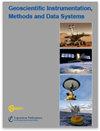Automated static magnetic cleanliness screening for the TRACERS small-satellite mission
IF 2.3
4区 地球科学
Q3 GEOSCIENCES, MULTIDISCIPLINARY
Geoscientific Instrumentation Methods and Data Systems
Pub Date : 2024-02-21
DOI:10.5194/gi-13-43-2024
引用次数: 0
Abstract
Abstract. The Tandem Reconnection and Cusp Electrodynamics Reconnaissance Satellites (TRACERS) Small Explorers mission requires high-fidelity magnetic field measurements for its magnetic reconnection science objectives and for its technology demonstration payload Magnetometers for Innovation and Capability (MAGIC). TRACERS needs to minimize the local magnetic noise through a magnetic cleanliness program such that the stray fields from the spacecraft and its instruments do not distort the local geophysical magnetic field of interest. Here we present an automated magnetic screening apparatus and procedure to enable technicians to routinely and efficiently measure the magnetic dipole moments of potential flight parts to determine whether they are suitable for spaceflight. This procedure is simple, replicable, and accurate down to a dipole moment of 1.59 × 10−3 N m T−1. It will be used to screen parts for the MAGIC instrument and other subsystems of the TRACERS satellite mission to help ensure magnetically clean measurements on orbit.TRACERS 小卫星飞行任务的自动静态磁洁净度筛选
摘要。串联再连接和尖顶电动力学侦察卫星(TRACERS)小型探索者任务需要高保真磁场测量,以实现其磁再连接科学目标及其技术演示有效载荷创新和能力磁强计(MAGIC)。TRACERS 需要通过磁洁净计划最大限度地减少本地磁噪声,从而使航天器及其仪器产生的杂散磁场不会扭曲感兴趣的本地地球物理磁场。在这里,我们介绍一种自动磁性筛选设备和程序,使技术人员能够定期、高效地测量潜在飞行部件的磁偶极矩,以确定它们是否适合太空飞行。该程序简单、可复制、精确到 1.59 × 10-3 N m T-1 的偶极矩。它将用于筛选 MAGIC 仪器和 TRACERS 卫星任务其他子系统的部件,以帮助确保轨道上的磁洁净测量。
本文章由计算机程序翻译,如有差异,请以英文原文为准。
求助全文
约1分钟内获得全文
求助全文
来源期刊

Geoscientific Instrumentation Methods and Data Systems
GEOSCIENCES, MULTIDISCIPLINARYMETEOROLOGY-METEOROLOGY & ATMOSPHERIC SCIENCES
CiteScore
3.70
自引率
0.00%
发文量
23
审稿时长
37 weeks
期刊介绍:
Geoscientific Instrumentation, Methods and Data Systems (GI) is an open-access interdisciplinary electronic journal for swift publication of original articles and short communications in the area of geoscientific instruments. It covers three main areas: (i) atmospheric and geospace sciences, (ii) earth science, and (iii) ocean science. A unique feature of the journal is the emphasis on synergy between science and technology that facilitates advances in GI. These advances include but are not limited to the following:
concepts, design, and description of instrumentation and data systems;
retrieval techniques of scientific products from measurements;
calibration and data quality assessment;
uncertainty in measurements;
newly developed and planned research platforms and community instrumentation capabilities;
major national and international field campaigns and observational research programs;
new observational strategies to address societal needs in areas such as monitoring climate change and preventing natural disasters;
networking of instruments for enhancing high temporal and spatial resolution of observations.
GI has an innovative two-stage publication process involving the scientific discussion forum Geoscientific Instrumentation, Methods and Data Systems Discussions (GID), which has been designed to do the following:
foster scientific discussion;
maximize the effectiveness and transparency of scientific quality assurance;
enable rapid publication;
make scientific publications freely accessible.
 求助内容:
求助内容: 应助结果提醒方式:
应助结果提醒方式:


